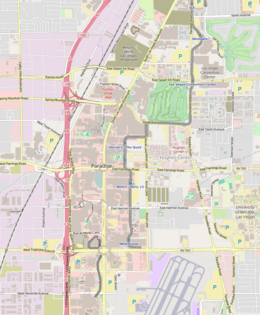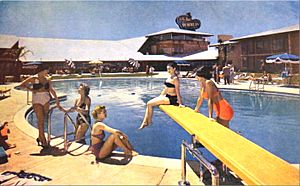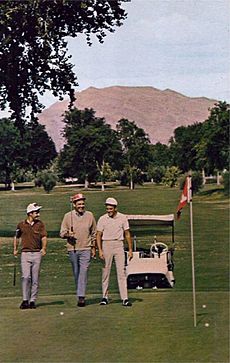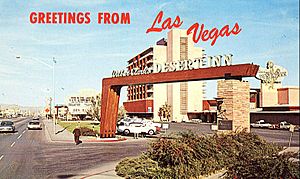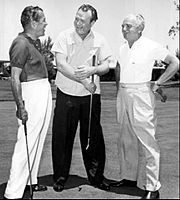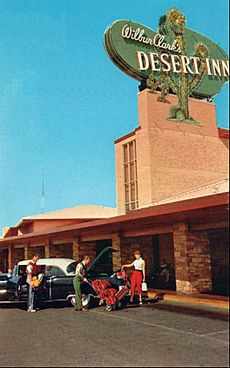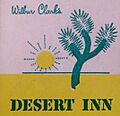Desert Inn facts for kids
Quick facts for kids Desert Inn Hotel and Casino |
|
|---|---|
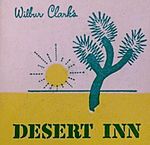 |
|
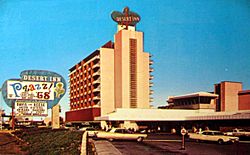
The Desert Inn in 1968
|
|
| Location | Paradise, Nevada, U.S. |
| Address | 3145 South Las Vegas Blvd |
| Opening date | April 24, 1950 |
| Closing date | August 28, 2000 |
| Theme | Desert |
| No. of rooms | 715 |
| Total gaming space | 35,000 sq ft (3,300 m2) |
| Signature attractions | Desert Inn Golf Course |
| Casino type | Land |
| Owner | 1964–1967 Moe Dalitz 1967–1988 Howard Hughes 1988–1993 Kirk Kerkorian 1993–1998 ITT / Sheraton Hotels and Resorts |
| Architect | Hugh E. Taylor (1950) William B. Tabler (1963) John Spohrer (1978) |
| Previous names | Wilbur Clark's Desert Inn, Sheraton Desert Inn |
| Coordinates | 36°07′43″N 115°9′59″W / 36.12861°N 115.16639°W |
The Desert Inn, also known as the D.I., was a famous hotel and casino in Las Vegas, Nevada. It was open for 50 years, from April 24, 1950, to August 28, 2000. It was the fifth big resort to open on the Las Vegas Strip.
The hotel started with 300 rooms and a fancy restaurant called the Sky Room. This restaurant offered amazing views of the Strip. The Desert Inn was also the first hotel in Las Vegas to have a beautiful fountain at its entrance. Over the years, it grew with new towers and underwent big renovations.
A famous 18-hole golf course was part of the resort. It hosted many important golf tournaments. Many famous people, including Frank Sinatra, performed and stayed at the Desert Inn.
In 2000, Steve Wynn bought the Desert Inn. He decided to close it down and build a brand new resort called Wynn Las Vegas and later, Encore Las Vegas. The old Desert Inn buildings were taken down in 2001 and 2004.
Contents
History of the Desert Inn
The Desert Inn was located at 3145 Las Vegas Boulevard South. It was first called Wilbur Clark's Desert Inn. Wilbur Clark started building it in 1947. He ran out of money, but then Moe Dalitz helped fund the project. Construction started again, and the hotel opened in 1950.
The grand opening on April 24, 1950, was a huge party. Many journalists and important guests were invited. Famous performers like Edgar Bergen and Charlie McCarthy entertained everyone. The Desert Inn quickly became known for its luxury and excellent service.
In the 1950s, Las Vegas was sometimes called the "Atomic City." The Desert Inn's Sky Room became a unique spot. Guests could watch distant atomic tests from a safe distance, which was a strange but popular activity at the time.
In 1964, Wilbur Clark sold his remaining share of the hotel. He passed away the next year. Many people remembered him as a key figure in making Las Vegas famous.
Howard Hughes and New Ownership
The Desert Inn's most famous guest was a businessman named Howard Hughes. He arrived in November 1966 and rented the top two floors of the hotel. When he was asked to leave for New Year's Eve, he decided to buy the entire hotel instead!
On March 27, 1967, Hughes bought the Desert Inn. This was the first of many Las Vegas hotels he would purchase. Hughes lived in his penthouse suite for four years. He was very private and rarely left his room. After Hughes passed away in 1976, the hotel continued to be updated.
In 1986, Kirk Kerkorian bought the hotel. It was then known as the MGM Desert Inn. In 1992, Frank Sinatra celebrated his 77th birthday at the hotel. It was a big event with many celebrities and media attention.
Later Years and Closure
In 1993, ITT Sheraton bought the resort for $160 million. It was renamed the Sheraton Desert Inn. They spent $200 million in 1997 to renovate and expand the hotel. It got a new look and a new tower called the Palms Tower. The hotel went back to its original name, The Desert Inn.
However, the hotel started losing money. In April 2000, the Desert Inn celebrated its 50th anniversary. There were parties and a celebrity golf tournament. A time capsule was buried, meant to be opened in 2050.
Just three days after its anniversary, Steve Wynn bought the resort for $270 million. He closed the Desert Inn on August 28, 2000. Wynn planned to build a new, modern resort on the site.
The Augusta Tower, one of the Desert Inn's buildings, was taken down in October 2001. The remaining towers were taken down in November 2004. This made way for the new Wynn Las Vegas resort.
Hotel Design and Features
The Desert Inn was designed to look like a "southwestern spa." It had a mix of ranch house and nightclub styles. The hotel's logo featured a Joshua tree cactus. The entrance had a beautiful fountain with "Dancing Waters" that moved to music.
The hotel's inside had redwood and flagstone floors. It had a casino, bars, a coffee shop, and various stores. The guest rooms were around a unique figure-eight swimming pool. Each of the original 300 rooms had its own air conditioning.
The Sky Room lounge was a three-story glass tower. It was the tallest building on the Strip when it was built. It offered amazing views of the desert and mountains.
The main performance area was the Painted Desert Room, later called the Crystal Room. It could seat 450 people. Charles Cobelle painted murals on the walls. There was also a special play area for children called the Kachina Doll Ranch.
Over the years, the hotel added more towers. The St. Andrews Tower was built in 1963. The 14-story Augusta Tower became the main tower in 1978. The Wimbledon Tower, with its unique pyramid shape, was also built then. By 1978, the hotel had 825 rooms and was known as the Desert Inn and Country Club. It had a golf club, tennis courts, and a large spa.
In 1997, a $200 million renovation gave the Desert Inn a new Mediterranean look. The number of rooms was reduced to 715 to make them more luxurious. A new lagoon-style pool was added, and the lobby was updated with marble.
Casino Fun
When it opened in 1950, the Desert Inn's casino was one of the biggest in Nevada. It had many games like craps, roulette, blackjack, and slot machines. It was known for attracting "high rollers," or people who liked to bet a lot of money.
In 2000, a lucky person won over $34 million playing a Megabucks slot machine at the Desert Inn. This was a record for Las Vegas at the time!
Golf Course and Country Club
The 18-hole Desert Inn Golf Club opened in 1952. It was a very important part of the resort. The course hosted the PGA Tour Tournament of Champions from 1953 to 1966. Famous golfers like Arnold Palmer and Jack Nicklaus played there.
The golf course was also important for making golf more welcoming to all players. It allowed Sammy Davis, Jr. to play, breaking old traditions. The course continued to host major tournaments for many years.
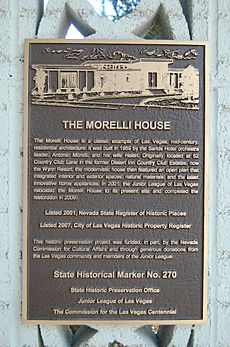
Many homes were built around the golf course. When Steve Wynn bought the resort, these homeowners had to sell their properties. One special house, the Morelli House, was saved from demolition. It was moved to downtown Las Vegas and is now a historic landmark.
Famous Performances
Almost every major star performed at the Desert Inn. Frank Sinatra made his Las Vegas debut there on September 13, 1951. He once joked that for "six bucks you got a filet mignon dinner and me."
Many other famous singers and entertainers graced the stage, including Noël Coward, Betty Hutton, Tony Martin, Eddie Fisher, Dinah Shore, Benny Goodman, Rosemary Clooney, and Wayne Newton. Wayne Newton was once the highest-paid nightclub performer, earning $10 million a year at the Desert Inn.
Music groups like Louis Prima and Keely Smith recorded their album On Stage live at the Desert Inn. Bobby Darin also recorded his album Live! At the Desert Inn there in 1971. In 1992, a week-long celebration for Frank Sinatra's 77th birthday brought many stars to the hotel.
The Desert Inn in Movies and TV
The Desert Inn was a popular spot for filming movies and TV shows.
- Parts of the 1960 movie Ocean's 11 were filmed there. It was one of the five Las Vegas hotels robbed in the movie.
- In the 1985 film Lost in America, a character loses money at the Desert Inn.
- The opening scene of the 1993 film Sister Act 2: Back in the Habit took place in the hotel's Grand Ballroom.
- The 2001 movie Rush Hour 2 used the Desert Inn as a filming location shortly before it was taken down. It was changed to look like an Asian-themed casino called the "Red Dragon."
The hotel was also the main setting for the TV show Vega$, which aired from 1978 to 1981. The 1980s show Dynasty and the NBC series Remington Steele also featured the Desert Inn.
Legacy of the Desert Inn
Many people were sad when the Desert Inn closed in 2000. It felt like the end of an era for "old Las Vegas." Historians say that the Desert Inn, along with other classic hotels, truly represented the image of Las Vegas for many years. It was a beloved place for both tourists and locals.
Desert Inn Road
Desert Inn Road is a major road in the Las Vegas Valley. It is about 17 miles long and runs from west to east. A special 2.5-mile expressway section, called the Desert Inn Road Super Arterial, helps traffic move quickly between different parts of Las Vegas. This expressway opened in 1996.
Images for kids


